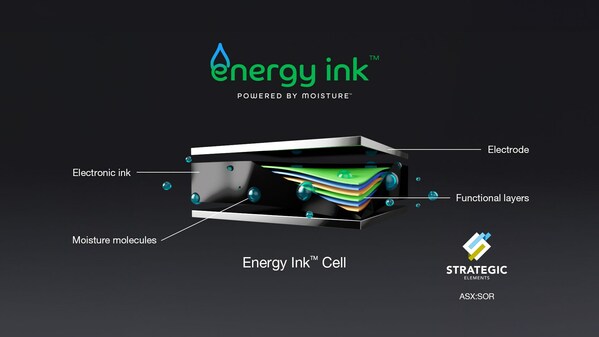PERTH, Australia, Nov. 14, 2023 /PRNewswire/ -- Strategic Elements Ltd (ASX Code: SOR) (Company) is pleased to report that the Energy Ink™ (renewable energy technology) has achieved unprecedented power density from moisture in the air. The Energy Ink™ technology takes moisture from the air – humidity – and converts it into electrical power.
Power density is a measure of how much power can be produced in a given area and is a crucial metric for comparing emerging technologies with established systems. To enable comparison, a standardised 1cm2 area is used. In laboratory conditions, a 1cm2 prototype high-power Energy Ink™ cell successfully exceeded the power density of solar cells used in commercial solar panels.
Technologies like the Energy Ink™ that use moisture as a high-power energy source have significant technical issues in low power density, short duration and material degradation. Thus, there has been a preconception that moisture is only suitable for small devices. The Energy Ink™ was successfully re-engineered to achieve a significant 1000-fold increase in power density in under 12 months. This achievement challenges the conventional notion that moisture is limited to powering small devices.
Australian Advanced Materials (AAM) (100% owned) and the University of New South Wales (UNSW) have worked together on printed electronics over many years and were awarded a prestigious Australian Research Council Linkage Grant to progress moisture as an energy source for wearables.
"We are very excited that the Energy Ink has achieved such high power density at this early stage. We believe there is still great potential to improve the device performance further and aim to scale up in the near future." - UNSW Professor Dewei Chu.
"Our early-stage achievement expands the potential of the Energy Ink™ beyond small devices. The 1,000-fold increase in power density in under 12 months represents a leap forward in harnessing moisture as an energy source. It is a testament to the dedication of the AAM/UNSW team. Achieving the required power and duration of high-power cells, as well as upscaling fabrication of numerous cells and electrodes, are formidable challenges for the Energy Ink™. Notwithstanding this, we have set an ambitious goal for the coming year. That is, to generate energy from moisture in an apartment building parking bay overnight, store a small charge into an electric vehicle and drive it away" - Charles Murphy, MD, Strategic Elements Ltd.
High-Power Cell: Technical Details
Power density is expressed and compared in terms of milliwatts per centimetre squared. The prototype high-power Energy Ink™ cell reported an average power density of 51 mW/cm², peak power density of 61 mW/cm² and concluded the three-hour test period with 32 mW/cm². Testing was conducted under a fixed resistive load without power management or humidity control. These results greatly exceed published moisture-enabled power generation technologies, with the majority significantly under 0.5 mW/cm2.
The pace of the progression in Energy Ink™ power density is highly encouraging. Bell Labs launched the modern solar tech era in 1954 by introducing a 6% efficient silicon solar cell (6 mW/cm²) initially used in space. In 2023, commercial panels average 20% efficiency (20 mW/cm²). The Company does not view the technology as a competitor to solar. The unique attributes of the Energy Ink™ technology potentially enable it to complement solar or act as a solution for renewable energy where solar isn't practical.
Whilst these are promising early results, significant hurdles exist for the Energy Ink™ to reach technical feasibility in high-power cells, including a) efficiency: achieving high energy conversion efficiency to make the technology competitive; b) stability: ensuring consistent performance over time, without significant degradation and c) scalability: transitioning from small, laboratory-scale prototypes to a more extensive, integrated system.
Moving Forward
The Energy Ink™ is still the first of its kind to demonstrate the potential to power small devices by powering a commercial skin patch and associated sensor/Bluetooth. In the near term, the small device Energy Ink™ cell will be significantly upgraded with technical innovations of the high-power Energy Ink™ cell. Integration of these developments and initial performance testing will be conducted in early 2024. The Company is developing a forward plan for high-power Energy Ink™ development and will keep shareholders duly informed of any material developments.
Energy Ink™ Renewable Energy
Energy Ink™ cells generate energy from moisture in the air to potentially directly power a device or provide energy for battery storage. Energy Ink™ differs from other renewable energy technologies in key areas:
- Potential to regulate its energy source (moisture) within a dedicated unit, workable indoors/outdoors, day or night, which may improve versatility and consistency of supply.
- Energy generation from moisture enables cells to be stacked vertically, offering higher output in less space, unlike solar, which needs to be horizontally laid out.
- Super lightweight and thin layers made from environment-friendly, non-flammable materials enhance the potential for mobility, recyclability and safety.
About Strategic Elements Ltd
Strategic Elements operates as a 'Venture Builder' by sourcing and combining teams of leading scientists or innovators. The Company majority funds the initial development of each Venture whilst seeking a major strategic investor/partner to assist commercialisation. The Australian Federal Government has registered Strategic Elements as a Pooled Development Fund (PDF) with a mandate to back early-stage Australian innovation. The PDF program provides the Company with a highly beneficial tax structure for the Company and its shareholders.
 Pages you might like
Pages you might like








 Latest information
Latest information
 Follow official account
Follow official account
 Online support
Online support
 鄂ICP备2022017323号
鄂ICP备2022017323号
 鄂公网安备 42018502006493
鄂公网安备 42018502006493
 Launch Exhibition
Launch Exhibition
 Release information
Release information




 Today's topic
Today's topic















